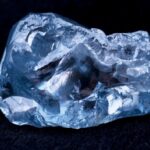 These cupriferous tourmalines from the Mina da Batalha in the Federal Brazilian State of Paraiba are small, rare and precious. Their spirited turquoise to green colours are such as are not found in any other gemstone in the world. The exclusiveness of this legendary find makes these rare gemstones real treasures.
These cupriferous tourmalines from the Mina da Batalha in the Federal Brazilian State of Paraiba are small, rare and precious. Their spirited turquoise to green colours are such as are not found in any other gemstone in the world. The exclusiveness of this legendary find makes these rare gemstones real treasures.
Paraiba – the word has a particular fascination for the connoisseur, for it is the name of a gemstone with blue to green tones of extraordinary vividness. It was not discovered until very recently, that is to say in the 1980s. The world has one man and his unshakable belief to thank for the discovery of this unique gemstone: Heitor Dimas Barbosa. Tirelessly, he and his assistants spent years digging in the pegmatite galleries of some modest hills in the Federal Brazilian State of Paraiba.
Heitor Dimas Barbosa was more than just someone looking for gemstones: and apart from that he wasn’t even looking for anything the existence of which had already been proved. The man was absolutely convinced that somewhere beneath the ‘Paraiba hill’ – famous today – he was going to find something ‘completely different’. And right he was. In 1981 he began with the first preparations for excavations at an old, dilapidated opencast mine. He had one deep hole after another drilled in the hard ground – without success. But suddenly, five and a half years after the cut of the first spade, the first signs of a tourmaline find manifested themselves in the tangle of galleries, shafts and tunnels. Finally, in the autumn of 1989, a handful of the finest tourmaline crystals were brought up into the daylight from one of the many galleries – in colours of which people had so far only been able to dream. Unfortunately, just at that time, of all times, the ‘father of the Paraiba tourmalines’ was busy getting over an illness and was not able to be present at the mine. Indeed the raw crystals were sold without his having seen them! When word of the find had got around, there was a period of frantic activity at the mine. For a further five years, the now-famous hill, only 400 metres long, 200 metres wide and 65 metres high, was combed, and even razed to the ground in places. But it was all for nothing. There is now hardly any expectation that further finds will be made.
It’s copper that makes the difference
 Brazil is the classical country of tourmalines. Members of this splendid gemstone group come in practically all the colours of the rainbow. For a long time, however, a radiant turquoise was lacking – that is, until the discovery of that precious deposit in Paraiba.
Brazil is the classical country of tourmalines. Members of this splendid gemstone group come in practically all the colours of the rainbow. For a long time, however, a radiant turquoise was lacking – that is, until the discovery of that precious deposit in Paraiba.
Normally, iron, manganese, chrome and vanadium are the elements responsible for the beautiful colouring in tourmalines. The Paraiba tourmaline is different: it owes its splendid colour to copper, an element which has never before been observed in a tourmaline. Indeed quite a fair proportion of its weight consists of copper. But scientists have discovered that it often also contains manganese.
In the Paraiba tourmaline, the interplay between these two elements gives rise to a variety of fascinatingly beautiful colours: emerald green, turquoise to sky blue, sapphire blue, indigo, bluish-violet, and purple. Certain proportions in the mixture of copper and manganese can also result in pale grey to violet-blue tones. Copper in high concentrations is responsible for the highly coveted radiant blue, turquoise and green hues, while violet and red tones are caused by manganese. By means of the burning technique, experienced cutters can eliminate the red colour components, with the result that only a pure copper colour remains.
However, the extraordinary vividness of the Paraiba tourmalines does not reveal itself until the stone has been cut. Faceted, they scintillate a really unusual ‘fire’ and appear to glow intensely even when there is very little light. That is why their colour is often referred to as ‘electric’ or ‘neon’. The aura of these treasures of Nature is both fresh and spirited at the same time. The ‘swimming-pool-blue’ of a Paraiba tourmaline positively flashes with vivacity, and you don’t have to be an expert to see it.
Paraiba tourmalines are almost always quite small, since the beautiful cupriferous tourmaline crystals from the ‘noble hill’ in Paraiba were almost all fragments when they were discovered. Larger raw stones with a weight of over 5 grammes which had not cracked were rare, and only very few crystals had a weight exceeding 20 grammes. For that reason you are very unlikely to find a large Paraiba tourmaline at a jeweller’s or gemstone merchant’s – quite apart from the fact that few specialist merchants actually offer this highly esteemed gemstone rarity at all.
 The gemstone world was captivated from the very beginning by the beauty and spirited colours of the Paraiba tourmalines. In no time at all they achieved great popularity, and today they are among the most sought-after and most expensive gemstones in the world. Prices continue to climb, and have already reached a level which, earlier on, would not have seemed realistic for a tourmaline. Five-figure prices per carat are by no means exceptional for fine, large specimens from Paraiba. Within a very short time, the market positively soaked up the modest supply of raw stones, which is thoroughly understandable, since Nature had created a gemstone which was peerless in terms of its colour and luminosity. And without Heitor Dimas Barbosa’s vision of finding something ‘completely different’, we would probably never even have known about it.
The gemstone world was captivated from the very beginning by the beauty and spirited colours of the Paraiba tourmalines. In no time at all they achieved great popularity, and today they are among the most sought-after and most expensive gemstones in the world. Prices continue to climb, and have already reached a level which, earlier on, would not have seemed realistic for a tourmaline. Five-figure prices per carat are by no means exceptional for fine, large specimens from Paraiba. Within a very short time, the market positively soaked up the modest supply of raw stones, which is thoroughly understandable, since Nature had created a gemstone which was peerless in terms of its colour and luminosity. And without Heitor Dimas Barbosa’s vision of finding something ‘completely different’, we would probably never even have known about it.
Is Paraiba in Africa too?
Strictly speaking, that would have been the end of the Paraiba story. But Nature does have the odd surprise up its sleeve. Since the beginning of 2001 the story has entered its sequel, though it is set in a different part of the world. In that year, some shining blue-green tourmalines from Nigeria suddenly appeared on the market, rather like the ones which had until then come only from Paraiba. It was a real sensation: just like the Paraiba tourmalines, they didn’t reveal their true beauty until they had been subjected to a careful burning process. It is true to say that their colours are, in general, a touch lighter, but the difference is such that the layman will hardly notice it. Even the scientists have their work cut out to find features by which the difference can be told between tourmalines from Paraiba and copper tourmalines from Africa, for the chemism of the two kinds is also identical. Both of them get their beautiful colour from copper and manganese. So how is this possible? Is Paraiba now in Africa too? Of course not. But this example of one of the most precious gemstones in the world does illustrate for us some of the evidence of continental drift. To get at the explanation, what we have to do is take a world atlas and have a look at the outlines of the South American continent and of Africa. If in our thoughts we shift the coastline of South America eastward, we will find that it fits the west coast of Africa like a piece in a jigsaw puzzle. Nigeria nestles nicely by the north-east of Brazil. Thus we may suppose that the radiant copper tourmalines from Nigeria came into being under the same conditions as those from Paraiba, at a time before the ancient continent drifted apart. Is that the reason why it is so difficult to tell one from the other? This remains one of the great riddles in the fascinating world of gemstones. Gemstone lovers, however, simply rejoice in the fact that there are tourmalines from Africa in a spirited greenish-blue on the market, as an alternative to the legendary Paraiba tourmalines.

















